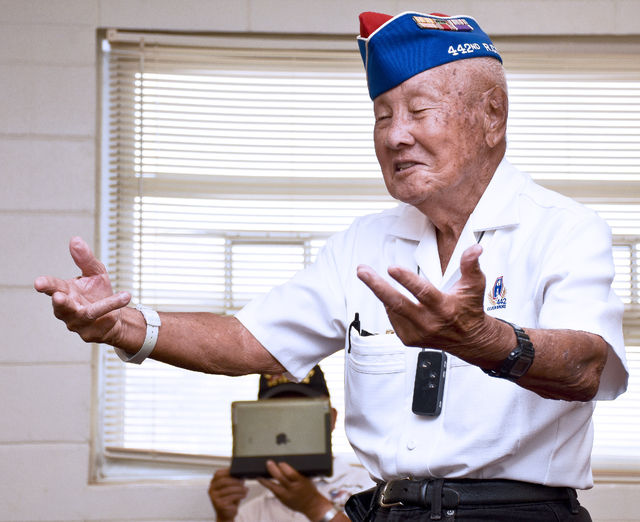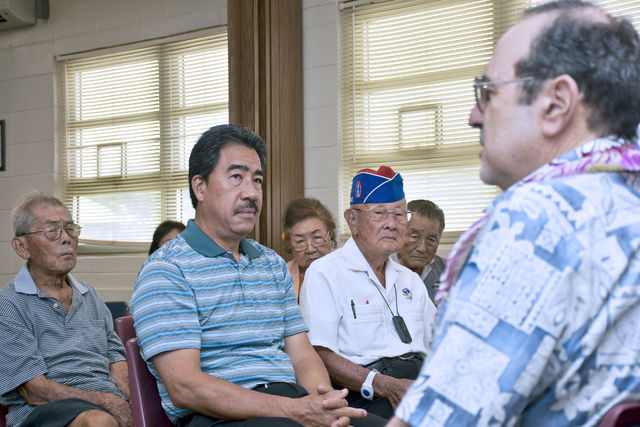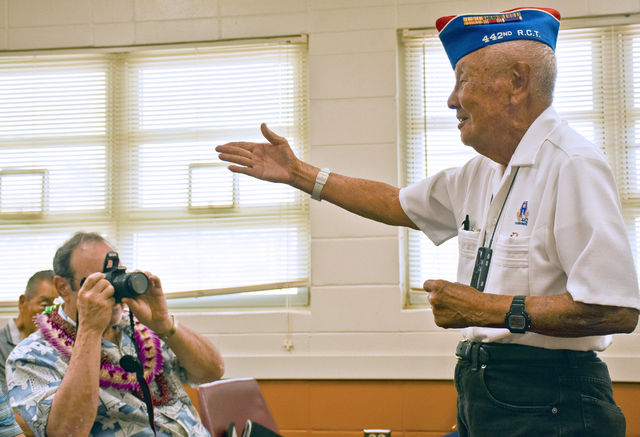LIHUE — “It was pitiful,” said Clinton Shiraishi, a Lihue veteran of the 522nd Field Artillery unit, his voice quaking with emotion, while reflection on a painful memory. “We saw them and started crying.” The Japanese American 522nd Field Artillery
LIHUE — “It was pitiful,” said Clinton Shiraishi, a Lihue veteran of the 522nd Field Artillery unit, his voice quaking with emotion, while reflection on a painful memory. “We saw them and started crying.”
The Japanese American 522nd Field Artillery Battalion was one of the driving forces that helped liberate Jewish survivors of the Landsberg-Kaufering Dachau Death March as well as Dachau sub-camps.
Shiraishi was among the World War II veterans — including Jiro Yukimura and Norman Hashisaka of the Military Intelligence Service, and their wives and other people interested in military history — who, on Saturday, visited with Eric Saul, creator of the “Go for Broke” exhibit that toured Kauai earlier this year at the Kauai Veterans Center.
The 522nd Field Artillery Battalion is credited with providing valuable support fire for the Japanese American 100th Infantry Battalion, and the 442nd Regimental Combat Team.
“This is something I was not aware of,” Saul said. “When I was done with the ‘Go for Broke’ exhibit, I got a visit from an individual who was very disturbed. ‘What about the Jews?’ he asked. ‘What about the 522nd Field Artillery?’ I had no idea what he was speaking of.”
The 522nd was activated on Feb. 1, 1943, in Camp Shelby, Mississippi. It earned the reputation as one of the fastest, most efficient artillery units in the European Theater operations in World War II.
“We used to pull 105mm howitzers with the Jeep,” Shiraishi, a retired judge, said. “That’s how we could go fast.”
In the spring of 1944, Jews, mostly Lithuanians, worked in concentration camps.
At the end of the war, the captives, Saul estimating approximately several thousand, were sent on a death march from Dachau to Tyrol.
“The remnants of the once glorious Lithuanian Jewry died from starvation, exhaustion, and freezing weather and their bodies lay strewn about where they fell and were shot,” Holocaust survivor Solly Ganor wrote in a July, 2006 essay.
Ganor survived the death march, being liberated by units of the 522nd Field Artillery Battalion of the U.S. Army.
The person who saved Ganor was Pvt. Clarence Matsumura, the same individual who asked Saul about leaving out the 522nd Field Artillery.
“I didn’t know,” Saul said. “This was the first I heard about the Japanese Americans fighting in Germany. That made me include a section on the 522nd Field Artillery Battalion.”
Saul was in Hawaii as part of the “Unlikely Liberators” exhibit, a partnership with the Nisei Veterans Legacy Center in Honolulu and Temple Emanu-El showing at the Temple Emanu-El in Nuuanu through Sept. 6. The exhibit tells the tale of the 522nd Field Artillery Battalion and the liberation at Dachau.
It moves to the Kahala Mall in Honolulu Oct. 5-24.
The small unit who happened on the Jewish population at Dachau tended to them for several days, Saul said.
“They fed them from their meager rations, taking care to liquify the food because the Jews, after about five years of mistreatment, could not handle solid food,” Saul said. “This went on for several days.”
Saul, a former curator of the Military Museum at the Presidio of San Francisco, said the Nisei soldiers played a big role in the Civil Rights Movement in addition to proving their patriotism to a questioning nation.
He said based on the agreement between King Kalakaua and the Japanese emperor, the Japanese people who came to Hawaii to labor on the plantations were just short of being slaves.
When World War II broke out, there were nearly 600 bills and laws enacted against them, labelling them as “alien enemy” and more.
Following the end of the war, the Nisei, who battled for America in the 100th Battalion, the 442nd RCT, the MIS, and the 522nd Field Artillery Battalion, worked tirelessly to repeal all of the bills and laws questioning their loyalty, Saul said.
“This is a fight that went beyond the battlefields,” Saul said. “The fight was a great step for the civil rights movement.”




